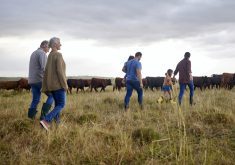If everything is tied up in fixed assets when a major change happens, even the best-managed farms can stumble and fall. Debts suddenly become unmanageable, family farms get bogged down in the mud of unachievable succession, and estates get devoured by tax liability.
Setting up a rational way to deal with these situations ahead has some upfront costs and requires some serious conversations. However, those costs are nothing compared to the headaches and costs of working out something after a major life change.
Life insurance is one tool to build strategies to solve these problems. “The No. 1 benefit of (life) insurance is liquidity,” says Rob Knight, investment adviser and director at HollisWealth Steward Group in Cambridge, Ont.
Read Also

Riding the tariff rollercoaster
Farmers are accustomed to roller-coaster years. But the current geopolitical windstorm is something else entirely. On his cattle operation near…
At death, life insurance payouts are generally used to cover debt, tax liability, funeral costs, and of course, to support a family. For family farms, life insurance can also be used to equalize inheritance and, if it’s done within a corporation, create a tax-friendly liquid investment.
The premiums are personal expenses, unless the insurance is to cover a loan required by a financial institution as security or if the farm is incorporated. The corporation can pay the premiums for the insurance policy with money earned at the lower corporate tax rate instead of personal income tax rate. At death, the payouts are tax free for the corporation and the proceeds can be moved out tax-free through the corporation’s capital dividend account (CDA).
The premiums can be significant and it’s imperative to have a good shareholder’s agreement for your corporation. A shareholder’s agreement helps navigate through death, divorce and disagreement. “It’s much easier to divide something up before you pile it up on the table,” says Knight.
Knight estimates only about half of the incorporated farms he works with have shareholders’ agreements, and of those, only about one-quarter include life insurance to fund them.
That’s partly because whole life insurance is costly. But it’s also because it’s complicated. Finding the right policy for you can be challenging. Generally, the younger the person, the cheaper it is to insure them. Trying to get life insurance once someone is sick or old can be costly or even impossible.
Although there are only five major insurance companies in the country, they have a multitude of policies and values, sold by a myriad of smaller companies. Each insurance company has its own sweet spot at any given time, says Knight. This sweet spot will change from time to time as these companies try to acquire different demographics.
“You should definitely go through an insurance broker,” Knight says.
Strategy 1: Farm corporation buys insurance
Basically, there are three parties to an insurance plan; the owner, the beneficiary and the person(s) whose life is insured. The corporation is both the owner and the beneficiary of the policy, and the farmers are the ones insured.
The income tax corporate rate is 16 per cent, compared to top-line personal rate of 46 per cent. So compared to paying for it personally, having the farm corporation pay the premiums can save about 30 per cent of cash flow.
However, those premiums still have to be an amount your corporation can sustain even in bad years. If you need to back out of a policy, it’s really not a good investment. Make sure you can afford the premiums for the duration.
If the plan is to sell or wind up the company in the future, there may be negative tax consequences on a future transfer of a life insurance policy out of the corporation. Also, corporately owned life insurance policies are vulnerable to the corporation’s creditors.
“Insurance rewards patience and consistency,” says Knight.
At death, the corporation is the beneficiary and gets this tax-free insurance payout. Then the money goes out of a notional account, called a capital dividend account (CDA) to the individual as stated in a shareholder’s agreement.
Whole life insurance policies can also be leveraged. Banks will loan up to 90 per cent of a whole life insurance policy’s value, with interest-only payments. Those interest payments for farm expansions or purchases are a tax-deductible expense for your corporation.
Strategy 2: Expand CDA
CDA accounts are a channel for money (not just insurance payouts) to come out of a corporation tax-free. “The CDA is a very useful account when you’ve got other corporate capital to liquidate,” says Knight.
One strategy Knight uses to inflate the CDA is to borrow against the insurance policy to buy more insurance. The larger the policy, the bigger the CDA amount allowed.
For example, let’s say you have a $1 million insurance policy and you go to the bank and get a loan (using the policy as collateral) to double the value of the policy to $2 million. At death, the corporation gets $2 million tax free and pays back the debt. The amount left of the insurance payout is at least the original policy value. In the process, the CDA credit has doubled, allowing for $1 million more capital to be taken out of the corporation tax-free.
What happens if Canada Revenue Agency changes the rules? Even if it does change the legislation, Knight says CRA has never applied new rules to old dates, so it won’t likely affect already-established life insurance policies.
Strategy 3: Equalize estates
Buying insurance on individuals can multiply the value of the investment in order to cover any tax liability or as a way to get money out of the corporation tax free. It’s also an affordable way to equalize inheritance for non-farming heirs.
If there isn’t insurance or other investments, the farm either has to pay siblings out over time, sell other assets, or give land to the rest of the family. For agriculture, land ownership can roll to children or spouse without being taxed.
However, Knight has seen some land inheritance conflicts arise recently with the big increase in land prices. The non-farming siblings want to sell their land for seven, eight or even 10 times the value that it was worth when it was given to them years ago. You can hardly blame them. However, the increase in prices means the farming sibling can’t afford to buy it, yet it’s needed for their operation.
Strategy 4: Cover debt
If your corporation is in growth mode, you might need insurance to cover debt payments at death or to pay out individuals.
For this, many businesses with shorter horizons will buy term insurance. Knight uses the example of three friends setting up a business which they intend to sell in 10 years. Term insurance is cheaper than whole life or universal insurance for businesses that require life insurance for shorter terms to cover loans or buyouts. “Ten to 15 years is the breaking point,” says Knight.
Multi-generational family farms by their nature are longer-term enterprises, so Knight generally recommends whole or universal life insurance. There’s an upper age limit to term insurance, he explains, and it won’t cover a permanent problem, such as the funding of an estate bequest or tax liability.
“Farms that are growing accumulate debt. Farms that are not growing accumulate capital,” says Knight.
Strategy 5: Shelter extra capital
“Another reason to buy insurance is to shelter redundant capital,” says Knight. A corporation may have too much capital. Maybe their children don’t want to farm so they don’t expand, or they don’t want to service debt or are nearing retirement.
The return on investment for whole insurance is not as appealing as trading equities, it ties up your money for a long time and only your beneficiaries get the big payout. However, it’s 100 per cent guaranteed and does multiply.
As well, if you’re afraid that your money won’t last to the end of your life, whole life policies can be borrowed against to use while you are alive.
Permanent life insurance can help diversify investments for farmers who want low-risk investments and have a large portion or all of their capital tied up in the farm. If the farm is incorporated, it can be a tax-efficient investment.














